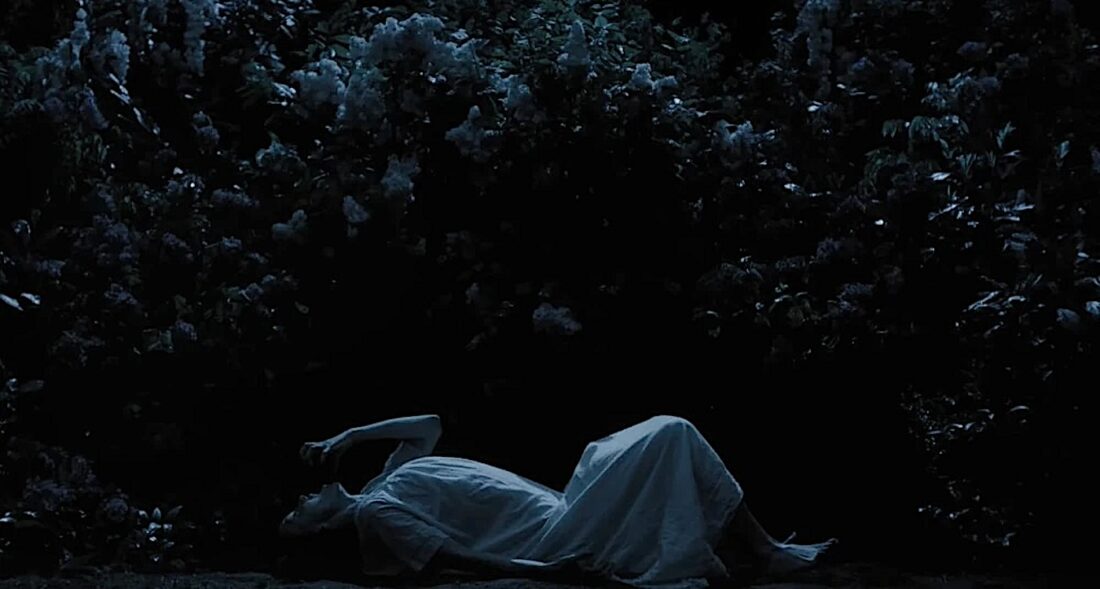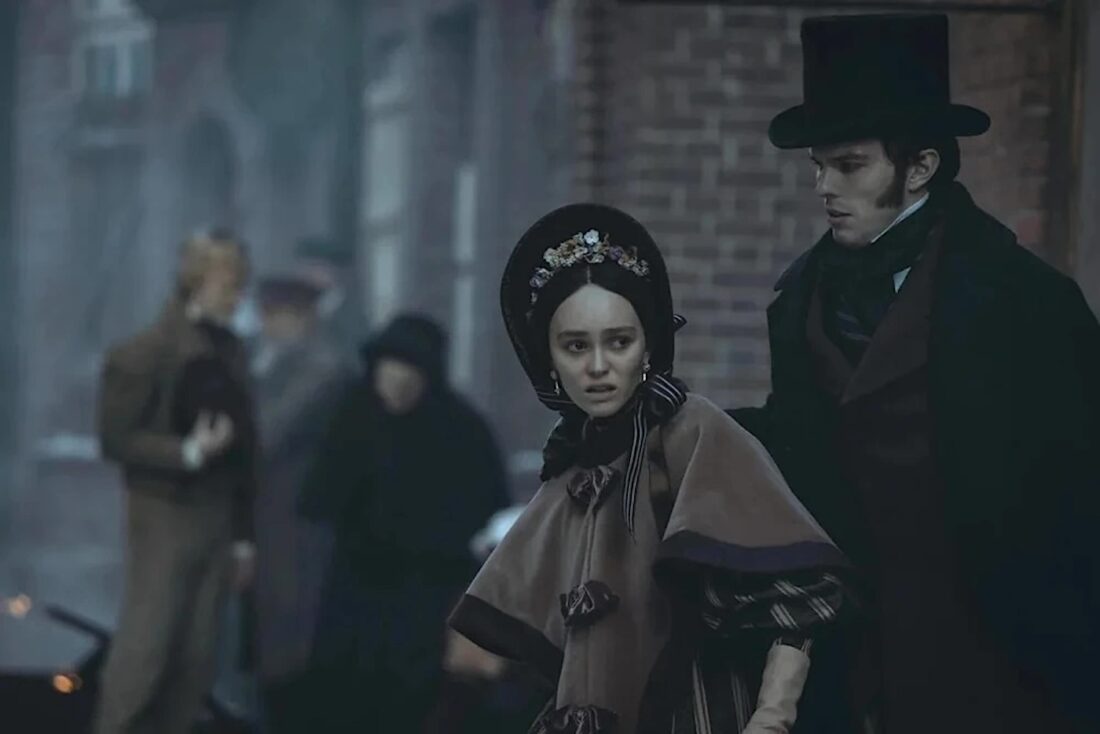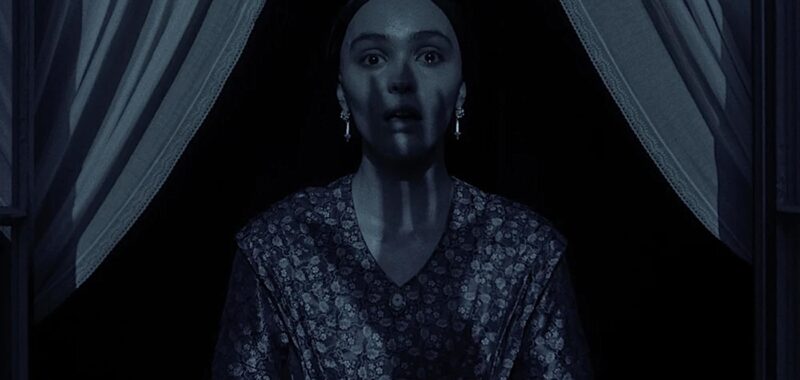At the center of Robert Eggers’ Nosferatu is a dark erotic entanglement between the monstrous Count Orlok (Bill Skarsgård) and the vulnerable Ellen Hutter (Lily-Rose Depp).
Like Dracula’s Mina Harker, Ellen is married to an upwardly-mobile young estate agent—in this case a 19th century German named Thomas Hutter (Nicholas Hoult), whose job takes him to Orlok’s castle in Transylvania. Back home in the gloomy town of Wisborg, Ellen experiences portentous visions and sensual nightmares, convinced that she and her husband are headed for certain doom.
Ellen’s supernatural prescience makes her a Cassandra-like figure, sharing urgent warnings of a danger that no one else can comprehend. Her dreams tell her that deadly peril is on its way, but by the time Orlok arrives in Wisborg, it’s too late. The latter half of the movie sees Orlok slaughter his way through town accompanied by a plague of rats, feeding on Ellen’s childhood friend Anna. Only then do the menfolk belatedly acknowledge that vampires are real.
In the end, Ellen is the only person qualified to defeat the Count. She succumbs to his predatory seduction and keeps him in bed until morning, at which point the sunrise transforms him into a desiccated corpse. Sex and death; the cornerstones of vampire fiction.
Many critics have praised the erotic atmosphere of Eggers’ Nosferatu, which involves a great deal of writhing and panting from Lily-Rose Depp. In one of several key differences from Dracula (the original 1922 Nosferatu’s main source material), Ellen isn’t a new victim of the demonic Count, but rather a longtime target. Long before she married Thomas, the lonely young Ellen reached out for psychic companionship, accidentally creating a link with Orlok’s spirit. The resulting relationship represents her sexual awakening, although not in any positive sense of the term. Years later Orlok is still obsessed with her from afar. Meanwhile Ellen suffers from traumatic symptoms that her friends and family fail to understand. Her fear of Orlok is tied up in unwanted desire, struggling to escape the Count’s magnetic pull.

Here is where Eggers’ vision falters, because although he’s famously skilled at creating atmospheric setpieces, he lacks a facility for romance. And indeed this is meant to be a romance, albeit a toxic and abusive one, with Eggers citing Wuthering Heights as a key source of inspiration.
What we really need here—and what the film ultimately lacks—is an equal, two-sided depiction of what draws Orlok and Ellen to each other. But the passion just isn’t there. If anything, this version of Nosferatu is rather chilly and pared-down, directed by a filmmaker who is best known for his technical precision. Inviting comparisons to a long lineage of horny horror movies (Park Chan-wook’s Thirst, Andrzej Żuławski’s Possession, the Hellraiser franchise), Eggers’ Nosferatu makes little effort to immerse us in its central relationship, relying on a shallow brand of sensuality.
In the introductory scene, Ellen wakes from a nightmare and pleads with Thomas to stay in bed, foreshadowing a dynamic where she’s torn between her wholesome husband and the Count’s perverse appeal. Handwaving his wife’s request, Thomas goes to work and unwittingly plays into Orlok’s machinations. His boss Herr Knock is already the Count’s long-distance thrall, conspiring to bring his master to Wisborg—and therefore closer to Ellen.
For Ellen, Thomas represents a reassuring tether to civilized society, shielding her from the invasive supernatural presence in her dreams. Once Thomas leaves town, her mental health deteriorates. Her friends call a doctor, who ties her down, doses her with opiates, and tells her to sleep in a corset. It’s both a hilariously on-the-nose reaction to Horny Goth Syndrome, and a tragic example of people suppressing a woman’s symptoms instead of confronting the underlying problem. The more they try to subdue Ellen’s fears and desires, the more those feelings bubble to the surface—and the less rational she appears.

It’s classic material for gothic horror, fueled by repression, lust, exoticized villains and 19th century social mores. Ellen’s friends perceive her as hysterical, but her madness provides a window to a deeper, darker truth. Aside from the occult-obsessed Professor Eberhart Von Franz (Willem Dafoe), the educated men of Wisborg require incontrovertible proof of Orlok’s powers before they believe what Ellen has known all along.
Robert Eggers’ 19th century vision
Robert Eggers made his name with a very particular brand of historical authenticity—one that speaks to the spirit of the setting, rather than just the physical trappings. In The Witch, puritan paranoia about devil-worship is grounded in lived experience. In The Northman, the main characters follow a path of mythic destiny like figures in a viking saga. Now Nosferatu delves into a 19th century mindset, with Ellen Hutter as a very recognizable type of tragic hypersexual waif, trapped in a gothic fairytale.
Ellen and Thomas begin the story in a genteel world of commerce and modern medicine, surrounded by prosperous characters with English accents. By contrast the filthy Orlok is an ancient foreign interloper, speaking in a thick Eastern European cadence and invading their home with communicable disease and bloodlust. In a similarly dubious nod to Bram Stoker’s Victorian xenophobia, Thomas’s journey includes an interlude with superstitious Bohemian peasants and Romani musicians.
Flipping the script on the immortal beauty of recent vampire icons like Lestat and Edward Cullen, Orlok is utterly repulsive. Not content with recreating the rodent-like villain of the 1922 Nosferatu, Eggers drew inspiration from early European vampire folklore, outlining a more ghoulish breed of monster.
Bill Skarsgård’s Orlok is a decaying cadaver with a ragged mustache, claw-like hands, and a roaring voice that sends Thomas into a gibbering panic. And like the unwashed protagonists of The Lighthouse (in my view Eggers’ best film), he gives the distinct impression of being incredibly stinky. Orlok’s presence is so fearsome that the camera shies away from revealing a full portrait, occasionally highlighting a single hand or a portion of his face, but otherwise depicting him shrouded in darkness.
This monstrousness sets Nosferatu apart from the vast majority of vampire movies, positioning Orlok as repugnant and unsympathetic. Therein lies the problem, because Eggers is so intent on making Orlok scary that he forgets to make him attractive. Not in the sense that Orlok should be any less disgusting, but rather that the disgustingness itself needs to be somehow desirable.
Nosferatu, Bram Stoker’s Dracula, and the legacy of gothic romance
In terms of what we actually see onscreen, Nosferatu’s eroticism focuses exclusively on Ellen, a conventionally beautiful young woman. We watch her sweat through nightgowns and moan while strapped to a bed, dreaming of the monster. To be honest, it’s not exactly groundbreaking for vampire cinema. The genre was practically founded on heaving bosoms, and despite Orlok’s lustful motives, there’s very little sensuality to his screen presence. Eggers doesn’t invite us to see him as a source of erotic allure, even though that’s clearly what Ellen is experiencing. Even his voice is an issue. With Orlok shouting or roaring every second line, he’s hard to accept as an insidious seducer.
Most vampire movies operate on easy mode when it comes to sex appeal. They lean into neck-sucking imagery and tales of forbidden love, casting charismatic actors to hypnotize their human prey. But when it comes to creating a seductive atmosphere around offbeat types of vampire, more creative effort is required.
Guillermo del Toro’s directorial debut Cronos is a potent example, starring Federico Luppi as an elderly antiques dealer who becomes infected with vampirism. In one memorable scene he spots a man with a nosebleed and follows him into a public bathroom, where he ends up licking splatters of blood from the floor, desperate for a fix. It’s a powerful moment of literal bloodlust, evoking vampiric desire without including any of the typical ingredients: hot people, sexual tension, or symbolic penetration of vulnerable skin. Instead del Toro takes a scenario that’s objectively disgusting and uncomfortable, and forces the audience to understand its appeal.
Eggers’ Nosferatu simply doesn’t manage to do this. In that regard (and several others) it’s a less effective adaptation than Francis Ford Coppola’s Dracula—a film that shares similar artistic goals, but evokes a very different mood.
Both Eggers and Coppola aim for morbid 19th century melodrama, boasting gorgeous production values and star-studded casts. Both also focus on the relationship between the vampire and the ingenue, with Coppola positioning Mina Harker as the reincarnation of Dracula’s long-dead wife. Plot quibbles aside, the biggest difference between these two films is the tone of their respective villains, with Coppola offering a relatively traditional take on Dracula as a predatory aristocrat. His Dracula is also more overtly sexual, including when he’s portrayed as a decrepit old man in the first act, leering at Keanu Reeves’ Jonathan Harker. (Eggers doesn’t really bother with any homoerotic stuff between Orlok and Thomas; another missed opportunity.)
Coppola’s approach to sex ranges from grotesque and theatrical to darkly romantic. Tapping into the dynamic between the two female leads in the novel, Winona Ryder’s Mina is somewhat repressed while her best friend Lucy is bubbly and flirtatious, juggling several suitors before being targeted by the Count.

One gorgeously lurid scene sees Mina follow Lucy outside in the middle of the night, where Lucy sashays through a garden maze to meet her lover: Dracula in werewolf form, with an oversized furry body and the snub nose of a vampire bat. Mina wears an innocent baby-blue gown while Lucy wafts through the darkness in translucent, cleavage-bearing red fabric. Sprawled in front of a moonlit mausoleum, she writhes in ecstasy with the beast, who drinks blood from her neck. Mina looks on in morbid fascination, waiting to comfort a limp and post-coital Lucy after she “wakes up from her dream.”
Elsewhere in Bram Stoker’s Dracula, the Count’s scantily-clad brides seduce Jonathan Harker into an orgy, and Mina finds herself drawn to Dracula himself. He takes her on dates, telling her about his homeland and the tragic loss of his wife. They both seem hypnotized by each other, framed in intimate shots full of rustling fabric and whispered dialogue. Like Orlok he embodies a dark temptation, calling back to a core tenet of gothic fiction: the lure of toxic romance.
Starting out with The Castle of Otranto in the 1760s, gothic storytellers have spent more than two centuries reworking a collection of familiar tropes. Claustrophobic households, mental breakdowns, religious imagery and tragic hauntings abound. Particularly popular in the 19th century, these stories don’t have to include a supernatural element, but they often focus on destructive relationships.
The classic format for gothic romance involves a young woman and a troubled or controlling man, like Jane Eyre, Wuthering Heights or Rebecca. (Or Twilight, if you permit your gothic heroines to wear khaki skirts.) Two recent TV adaptations explore queer versions of this dynamic: NBC’s Hannibal (which reinvents FBI agent Will Graham as a mentally unstable waif opposite Hannibal Lecter’s seductive European aristocrat) and AMC’s Interview with the Vampire (which brings more overt sexuality to Anne Rice’s self-destructive vampire romance).

These shows feature point-of-view characters who start out as awkward outsiders in conventional society (like Ellen Hutter), and go through a transformation after meeting their murderous love-interests. In both cases this transformation is tied up in sensual imagery, with Hannibal earning praise for its cannibal cuisine and theatrical crime scenes, and Interview with the Vampire going all-in on explicit sex, erotic blood-drinking, and the elaborate symbolism of its main “castle,” an oppressive luxury apartment in Dubai. Both dramas immerse us in a world where passionate emotion outweighs morality, exploring a multisensory experience of desire.
In the context of this long tradition of gothic romances, Nosferatu’s one-sided, gendered eroticism begins to feel a little basic. It also reflects a deeper problem with Eggers’ vision: Unlike his previous films, Nosferatu just isn’t very original. The Witch made a splash because it established a fresh approach to historical storytelling, whereas Nosferatu adapts a story we’ve seen dozens of times before, in a setting where Eggers’ methods do not offer anything new.
Vintage gothic fiction is already a foundational influence on horror cinema, and there’s a massive back-catalogue of Victorian historical dramas that illustrate the values of the time. Jane Eyre, Dr Jekyll and Mr Hyde and The Turn of the Screw lead into Crimson Peak, The Woman in Black and Lady Macbeth – and Interview with the Vampire, and The Haunting of Hill House, and countless Victorian pastiches. These stories have already introduced 19th century tropes and values into the public consciousness, making Eggers’ Nosferatu far less distinctive than his previous work. Ellen Hutter’s psychosexual torment seems almost rote and cliché compared to the stylized weirdness of The Lighthouse, and while the obscure vampire folklore (ie. drinking from the heart instead of the throat) presents a notable curiosity, it doesn’t do enough to differentiate this Nosferatu from previous Draculas. Technically impressive though it is, this is Eggers’ least interesting project to date, exploring familiar ideas while squandering their more grotesque potential.

